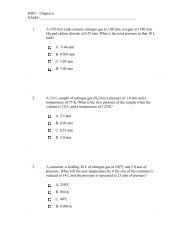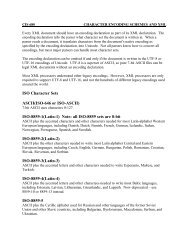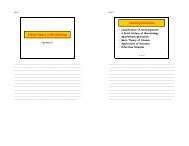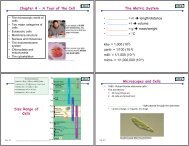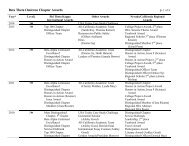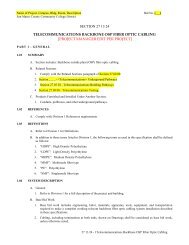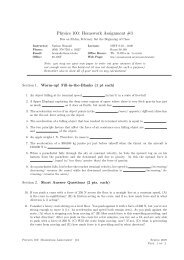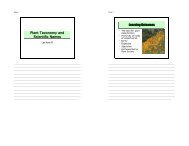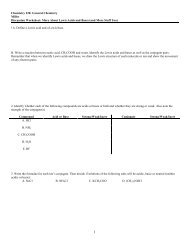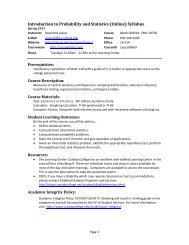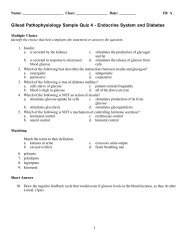CSM Introductory Physiology Fluid Balance Case Study
CSM Introductory Physiology Fluid Balance Case Study
CSM Introductory Physiology Fluid Balance Case Study
You also want an ePaper? Increase the reach of your titles
YUMPU automatically turns print PDFs into web optimized ePapers that Google loves.
<strong>CSM</strong> <strong>Introductory</strong> <strong>Physiology</strong> <br />
<strong>Fluid</strong> <strong>Balance</strong> <strong>Case</strong> <strong>Study</strong> <br />
BACKGROUND <br />
<br />
Mrs Davis is admitted to the hospital after 5 days of vomiting. She has<br />
been unable to eat anything for that time period. Her usual weight is<br />
126lb. On admission her weight is 118lb. Assessment reveals dry, cracked<br />
lips, poor skin turgor. BP= 88/72mm Hg, Pulse=102bpm, Respiratory rate<br />
(RR)=20, Temp = 38.6ºC. Urine output over the next 8 hours is 100ml.<br />
Lab studies reveal:<br />
Serum Na + = 126 mmol/L<br />
Serum K + = 2.9 mmol/L<br />
Cl - = 90 mmol/L<br />
Creatinine = 0.17 mmol/L<br />
(Normal)<br />
(135-146mmol/L)<br />
(3.5-5.0mmol/L)<br />
(95-110mmol/L)<br />
(0.05-0.12mmol/L)<br />
College of San Mateo<br />
Biology 260 <strong>Introductory</strong> <strong>Physiology</strong><br />
Martin Fall 2009<br />
Developed during sabbatical Spring 2009<br />
1
CASE ANALYSIS<br />
1. Identify the potential issues and major topics in the case. What is this case <br />
about? Underline terms or phrases that seem to be important to understanding <br />
this case. Then list 3 or 4 physiology related topics or issues in the case. <br />
<br />
<br />
<br />
<br />
<br />
<br />
<br />
2. What specific questions do you have about these topics? List what you already <br />
know about this case in the “What Do I know?” column. List questions you <br />
would like to learn more about in the “What Do I Need to Know?” column. <br />
<br />
What Do I Know? <br />
<br />
What Do I need to Know? <br />
<br />
3. Put a check mark by one to three questions or issues in the “What Do I Need to <br />
Know?” list that you think are most important to explore. <br />
<br />
4. What kind of references or resources would help you answer or explore these <br />
questions? Identify two different resources and explain what information each <br />
resource is likely to give that will help you answer the question(s). Choose <br />
specific resources. <br />
College of San Mateo<br />
Biology 260 <strong>Introductory</strong> <strong>Physiology</strong><br />
Martin Fall 2009<br />
Developed during sabbatical Spring 2009<br />
2
<br />
CORE INVESTIGATIONS<br />
I. Critical Reading <br />
Marieb & Hoehn, Human Anatomy and <strong>Physiology</strong> <br />
II. Interactive <strong>Physiology</strong> <strong>Fluid</strong>s and Electrolytes <br />
Topics: Introduction to Body <strong>Fluid</strong>s, Water Homeostasis, Electrolyte <br />
Homeostasis <br />
III. Questions <br />
1. What signs and symptoms would suggest Mrs. Davis is<br />
hypovolemic?<br />
2. Mrs. Davis passed 100ml of urine in 8 hours, if this continued at<br />
the same rate how much urine would she pass in 24 hours? Is<br />
this normal?<br />
3. Mrs. Davis is dehydrated from her continuous vomiting and lack<br />
of intake for 5 days. List some other common causes for<br />
dehydration.<br />
4. If Mrs. Davis’s hypovolemia were associated with hypernatremia<br />
would body cells shrink or swell? Why?<br />
5. What are normal sodium and potassium levels? What are these<br />
ions used for? What are the primary compartments in which<br />
they are found.<br />
6. Name some common food sources of sodium and potassium.<br />
Can you name food sources for phosphorous, calcium and<br />
magnesium as well?<br />
7. What mechanisms does the body use to maintain fluid balance.<br />
Draw a concept map representing these mechanisms.<br />
8. Is Mrs. Davis’s fluid imbalance associated with hypo or<br />
hypernatremia? Hypo or hyperkalemia?<br />
9. State 3- 5 reasons why elderly people are more at risk for<br />
dehydration than young adults.<br />
<br />
College of San Mateo<br />
Biology 260 <strong>Introductory</strong> <strong>Physiology</strong><br />
Martin Fall 2009<br />
Developed during sabbatical Spring 2009<br />
3
REFERENCES<br />
Mentes J , Buckwater K. (1997) Getting back to Basics: Maintaining<br />
Hydration to Prevent Acute Confusion in Frail Elderly, J . Gerontological<br />
Nursing 23: 48-51.<br />
Weinburg,A., Minaker, K.(1995) and the Council on Scientific Affairs.<br />
Dehydration: Evaluation and Management in Older Adults, J AMA; Vol 274<br />
<br />
University of Auckland School of Nursing, Nursing 104 Course Materials,<br />
Spring 2009<br />
<br />
Image from www.dailymail.co.uk <br />
College of San Mateo<br />
Biology 260 <strong>Introductory</strong> <strong>Physiology</strong><br />
Martin Fall 2009<br />
Developed during sabbatical Spring 2009<br />
4



